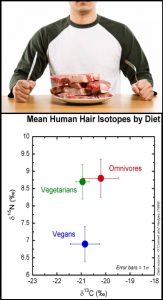[Past Projects]
Dr. Anne Wiley and Nate Michael
Could you tell what a stranger ate during the past month, using only a tiny sample of their hair? Could you predict their risk of diabetes, hypertension, or other chronic disease? These are the questions at the heart of our research… and potentially at the heart of your new project.

Unbeknownst to most people, our dietary history is recorded by subtle shifts in the chemical composition of our hair. Stable isotopes are alternative forms of an element that differ in their number of neutrons (e.g. 14N has 7 neutrons while 15N has 8); the ratio of these isotopes in human tissues are inherited from our food. For example, people who consume meat and other animal-based foods have more 15N in their hair than vegans. And the more corn syrup people consume, the more 13C will become concentrated in their blood. Because stable isotopes reflect aspects of diet such as sugar consumption that are linked with obesity and chronic disease, many researchers have predicted that they will have a powerful impact in future human health studies.
The goal of this project is to collect hair samples from University of Akron students and determine exactly what aspects of diet can (and can’t) be quantified using stable isotope techniques. We’re searching for a dedicated undergraduate who can help to collect hair samples from volunteers, help administer diet and health surveys, learn to analyze samples for their isotopic content in lab, and push our understanding about the isotope-diet link to the next level. The recruited student will join an interdisciplinary team (ecologists and stable isotope specialists, an anthropologist, and an expert in human movement) who are aiming to apply stable isotopes to the study of food availability and health in low-income Cleveland neighborhoods. The student may have the opportunity to join in the Cleveland-based research, depending on their timeline.
